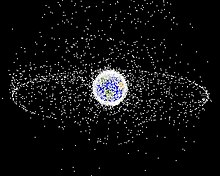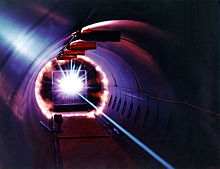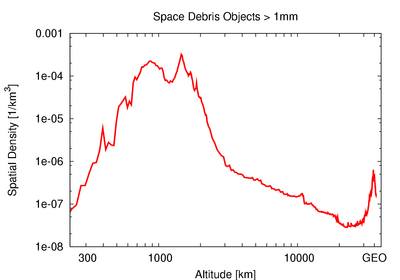Space debris: Difference between revisions
→Significant debris-creation events: Feb 20 event debris perigee |
|||
| Line 54: | Line 54: | ||
An event of similar magnitude occurred on [[February 19]], [[2007]], when a Russian [[Briz-M]] booster stage exploded in orbit over Australia. The booster had been launched on [[February 28]], [[2006]], carrying an [[Arabsat-4A]] communication satellite but malfunctioned before it could use all of its fuel. The explosion was captured on film by several astronomers, but due to the path of the orbit the debris cloud has been hard to quantify using radar. Although similar in magnitude, the debris field is at a lower altitude than the Chinese ASAT test and much debris re-enters the atmosphere in a relatively short time. As of [[February 21]], [[2007]], over 1,000 fragments had been identified.<ref>{{cite news| url=http://www.spaceweather.com/archive.php?view=1&day=21&month=02&year=2007| title=Rocket Explosion| date=22 Feb 2007 | accessdate=2007-02-21| publisher=Spaceweather.com}}</ref><ref>{{cite news| url=http://www.space.com/news/070221_rocket_explodes.html| publisher=Space.com| title=Rocket Explodes Over Australia, Showers Space with Debris| first= Ker| last= Than| date=21 February 2007| accessdate=2007-02-21}}</ref> A third breakup event also occurred on 14 February 2007 as recorded by Celes Trak.<ref>{{cite news|url=http://celestrak.com/events/debris-events.asp|publisher=celestrak.com|title=Recent Debris Events|accessdate=2007-03-16}}</ref> This makes three observed events in the first two months of 2007. In 2006, the most breakups occurred since 1993 with eight breakups.<ref>{{cite news|url=http://space.newscientist.com/article/dn10979-spate-of-rocket-breakups-creates-new-space-junk.html|publisher=NewScientist.com|title=Spate of rocket breakups creates new space junk|date=2007-01-17|accessdate=2007-03-16}}</ref> |
An event of similar magnitude occurred on [[February 19]], [[2007]], when a Russian [[Briz-M]] booster stage exploded in orbit over Australia. The booster had been launched on [[February 28]], [[2006]], carrying an [[Arabsat-4A]] communication satellite but malfunctioned before it could use all of its fuel. The explosion was captured on film by several astronomers, but due to the path of the orbit the debris cloud has been hard to quantify using radar. Although similar in magnitude, the debris field is at a lower altitude than the Chinese ASAT test and much debris re-enters the atmosphere in a relatively short time. As of [[February 21]], [[2007]], over 1,000 fragments had been identified.<ref>{{cite news| url=http://www.spaceweather.com/archive.php?view=1&day=21&month=02&year=2007| title=Rocket Explosion| date=22 Feb 2007 | accessdate=2007-02-21| publisher=Spaceweather.com}}</ref><ref>{{cite news| url=http://www.space.com/news/070221_rocket_explodes.html| publisher=Space.com| title=Rocket Explodes Over Australia, Showers Space with Debris| first= Ker| last= Than| date=21 February 2007| accessdate=2007-02-21}}</ref> A third breakup event also occurred on 14 February 2007 as recorded by Celes Trak.<ref>{{cite news|url=http://celestrak.com/events/debris-events.asp|publisher=celestrak.com|title=Recent Debris Events|accessdate=2007-03-16}}</ref> This makes three observed events in the first two months of 2007. In 2006, the most breakups occurred since 1993 with eight breakups.<ref>{{cite news|url=http://space.newscientist.com/article/dn10979-spate-of-rocket-breakups-creates-new-space-junk.html|publisher=NewScientist.com|title=Spate of rocket breakups creates new space junk|date=2007-01-17|accessdate=2007-03-16}}</ref> |
||
Additionally on February 20th, 2008, the US launched an [[SM-3 Missile]] from the [[USS Lake Erie]] specially designed to destroy a deffective US spy satellite feared to carry 1,000 pounds of toxic [[Hydrazine]] fuel. The debris created by this event occurring at about 250km altitude results in all the debris having a perigee of 250km. Although the apogee of some debris may be higher due to the explosion, the perigee remains at 250km and will result in all debris re-entering the atmosphere in a relatively short time period. <ref>>{{cite web|url=http://www.npr.org/templates/story/story.php?storyId=19227400|title=Pentagon: Missile Scored Direct Hit on Satellite| date=21 Feb 2008}}</ref> |
Additionally on February 20th, 2008, the US launched an [[SM-3 Missile]] from the [[USS Lake Erie]] specially designed to destroy a deffective US spy satellite feared to carry 1,000 pounds of toxic [[Hydrazine]] fuel. The debris created by this event occurring at about 250km altitude results in all the debris having a perigee of 250km. Although the apogee of some debris may be higher due to the explosion, the perigee remains at 250km and will result in all debris re-entering the atmosphere in a relatively short time period. <ref>>{{cite web|url=http://www.npr.org/templates/story/story.php?storyId=19227400|title=Pentagon: Missile Scored Direct Hit on Satellite| date=21 Feb 2008}}</ref> [[Orbit equation]] |
||
==Significant debris impact events== |
==Significant debris impact events== |
||
Revision as of 21:29, 14 March 2008


Space debris or orbital debris, also called space junk and space waste, are the objects in orbit around Earth created by humans, that no longer serve any useful purpose. They consist of everything from entire spent rocket stages and defunct satellites to explosion fragments, paint flakes, dust, and slag from solid rocket motors, coolant released by RORSAT nuclear powered satellites, deliberate insertion of small needles, and other small particles.[1] Clouds of very small particles may cause erosive damage, like sandblasting.
Space debris has become a growing concern in recent years, since collisions at orbital velocities can be highly damaging to functioning satellites and can also produce even more space debris in the process, called Kessler Syndrome. Some spacecraft, like the International Space Station, are now armored to mitigate damage with this hazard.[2] Astronauts on EVAs are also vulnerable.
History
In 1958, the United States launched a satellite named Vanguard I. It became one of the longest surviving pieces of space junk, and remained the oldest piece still in orbit through at least August 2007.[3]
According to Edward Tufte's book Envisioning Information, space debris objects have included a glove lost by astronaut Ed White on the first American space-walk, a camera Michael Collins lost near the spacecraft Gemini 10, garbage bags jettisoned by the Soviet Mir Cosmonauts throughout that space station's 15-year life,[3] a wrench and a toothbrush. Sunita Williams of STS-116 also lost a camera during extra-vehicular activity (EVA). During the EVA to reinforce a torn solar panel during STS-120 a pair of pliers was similarly liberated. Most of those unusual objects have re-entered the atmosphere of the Earth within weeks due to the orbits where they were released and their small sizes. Things like these are not major contributors to the space debris environment. On the other side, explosion events are a major contribution to the space debris problem. About 100 tons of fragments generated during approximately 200 such events are still in orbit. Space debris is most concentrated in low Earth orbit, though some extends out past geosynchronous orbit.
The first official Space Shuttle collision avoidance maneuver was during STS-48 in September 1991. A 7-second reaction control system burn was performed to avoid debris from the Cosmos satellite 955.
In 2006, wreckage from a Russian spy satellite passed dangerously close to a Latin American Airbus carrying 270 passengers, reentering over the Pacific Ocean which is considered among the safest places in the world to bring down satellites due to its unpopulated vastness. The worst uncontrolled reentry in history occurred in July 1979, when Skylab, America's abandoned, 78-ton space station - which had long since run out of maneuvering fuel - came down earlier than planned, raining debris across the Australian outback.[4]
Mitigation measures

In order to mitigate the generation of additional space debris, a number of measures have been proposed: The passivation of spent upper stages by the release of residual fuels is aimed at decreasing the risk of on-orbit explosions that could generate thousands of additional debris objects.
Taking satellites out of orbit at the end of their operational life would also be an effective mitigation measure. This could be facilitated with a "terminator tether," an electrodynamic tether that is rolled out, and slows down the spacecraft.[5] In cases when a direct (and controlled) de-orbit would require too much fuel the satellite can also be brought to an orbit where atmospheric drag would cause it to de-orbit after some years. Such a maneuver was successfully performed with the French Spot-1 satellite at the end of 2003. It will re-enter in approximately 15 years.
In orbital altitudes where it would not be economically feasible to de-orbit a satellite, like in the geostationary ring they are brought to a graveyard orbit where no operational satellites are present.
Proposals have been made for ways to "sweep" space debris back into Earth's atmosphere, including automated tugs, laser brooms to vaporize or nudge particles into rapidly-decaying orbits, or huge aerogel blobs to absorb impacting junk and eventually fall out of orbit with them trapped inside. However, currently most effort is being devoted to prevention of collisions by keeping track of larger debris, and prevention of more debris.
Other ideas include the gathering of larger objects into an orbital "junk yard", where they could be used as resources should future needs arise, while keeping them out of the way.
Space debris measurements

The U.S. Strategic Command maintains a catalogue currently containing about 13,000 objects, in part to prevent misinterpretation as hostile missiles. Observation data gathered by a number of ground based radar facilities and telescopes as well as by a space based telescope[6] is used to maintain this catalogue. Nevertheless, the majority of debris objects remain unobserved. There are more than 600,000 objects larger than 1 cm in orbit (according to the ESA Meteoroid and Space Debris Terrestrial Environment Reference, the MASTER-2005 model).
Other sources of knowledge on the actual space debris environment include measurement campaigns by the ESA Space Debris Telescope, TIRA[7], Goldstone radar, Haystack radar,[8] and the Cobra Dane phased array radar.[9] The data gathered during these campaigns is used to validate models of the debris environment like ESA-MASTER. Such models are the only means of assessing the impact risk caused by space debris as only larger objects can be regularly tracked.
Returned space debris hardware is also a valuable source of information on the (submillimetre) space debris environment. The LDEF satellite deployed by STS-41-C Challenger and retrieved by STS-32 Columbia spent 68 months in orbit. The close examination of its surfaces allowed the analysis of the directional distribution and the composition of debris flux. The EURECA satellite deployed by STS-46 Atlantis in 1992 and retrieved by STS-57 Endeavour in 1993 could provide additional insight.
The solar arrays of the Hubble Space Telescope returned during missions STS-61 Endeavour and STS-109 Columbia are an important source of information on the debris environment. The impact craters found on the surface were counted and classified by ESA to provide another means for validating debris environment models.

Gabbard diagrams
Space debris groups resulting from satellite breakups are often studied using scatterplots known as Gabbard diagrams. In a Gabbard diagram the perigee and apogee altitudes of the individual debris fragments resulting from a collision are plotted with respect to the orbital period of each fragment. The distribution of the resulting diagram can be used to infer information such as direction and point of impact.[10] [11]
Significant debris-creation events
The largest space debris incident in history was the Chinese anti-satellite weapon (ASAT) test on January 11, 2007.[12] The event was estimated to have created more than 2300 pieces (updated 12/13/07) of trackable debris (approximately golf ball size or larger), over 35,000 pieces 1cm or larger, and 1 million pieces 1mm or larger. The debris event is more significant than previous ASAT tests in that the debris field is in a higher orbital plane resulting in deorbit times of 35 years and greater. In June, 2007, NASA's Terra environmental spacecraft was the first to be moved in order to prevent impacts from this debris.[13]
An event of similar magnitude occurred on February 19, 2007, when a Russian Briz-M booster stage exploded in orbit over Australia. The booster had been launched on February 28, 2006, carrying an Arabsat-4A communication satellite but malfunctioned before it could use all of its fuel. The explosion was captured on film by several astronomers, but due to the path of the orbit the debris cloud has been hard to quantify using radar. Although similar in magnitude, the debris field is at a lower altitude than the Chinese ASAT test and much debris re-enters the atmosphere in a relatively short time. As of February 21, 2007, over 1,000 fragments had been identified.[14][15] A third breakup event also occurred on 14 February 2007 as recorded by Celes Trak.[16] This makes three observed events in the first two months of 2007. In 2006, the most breakups occurred since 1993 with eight breakups.[17]
Additionally on February 20th, 2008, the US launched an SM-3 Missile from the USS Lake Erie specially designed to destroy a deffective US spy satellite feared to carry 1,000 pounds of toxic Hydrazine fuel. The debris created by this event occurring at about 250km altitude results in all the debris having a perigee of 250km. Although the apogee of some debris may be higher due to the explosion, the perigee remains at 250km and will result in all debris re-entering the atmosphere in a relatively short time period. [18] Orbit equation
Significant debris impact events
The first verified collision with catalogued space debris occurred in 1996, tearing off a boom from the French satellite Cerise.[19]
Only one person has ever been recorded hit by manmade space debris: in 1997 an Oklahoma woman was hit in the shoulder by a 10 x 13 cm. piece of blackened, woven metallic material that was later confirmed to be part of the fuel tank of a Delta II rocket which had launched a U.S. Air Force satellite in 1996. She was not injured.[20][21]
On October 10, 2006, a brief Reuters report suggested a cottage in Germany was burned down by a fire that was speculated to have been started by a small bolide (no more than 10mm). The fire "badly burned the man's hands and face".[22][23]. The news item made no report of any tangible evidence being retrieved to substantiate the assumption.
See also
References
- ^ "Technical report on space debris" (PDF). United Nations. 1999. Retrieved 2006-04-05.ISBN 92-1-100813-1
- ^ Thoma, K.; Wicklein, M.; Schneider, E. (2005-08). "New Protection Concepts for Meteoroid / Debris Shields". In D. Danesy (editor) (ed.). Proceedings of the 4th European Conference on Space Debris (ESA SP-587). ESA/ESOC. p. 445.
{{cite conference}}:|editor=has generic name (help); Check date values in:|date=(help); Unknown parameter|booktitle=ignored (|book-title=suggested) (help)CS1 maint: multiple names: authors list (link) 18–20 April 2005 in Darmstadt, Germany. Abstract. - ^ a b Space junk, USA WEEKEND Magazine, by Julian Smith, August 26, 2007
- ^ [1], Time, by Jeffery Kluger, Jan. 28, 2008
- ^ Christensen, Bill. "The Terminator Tether Aims to Clean Up Low Earth Orbit". Retrieved 2006-03-08.
- ^ "The Space-Based Visible Program". MIT Lincoln Laboratory. Retrieved 2006-03-08.
{{cite web}}: Cite uses deprecated parameter|authors=(help) - ^ Klinkrad, H. "Monitoring Space - Efforts Made by European Countries" (PDF). Retrieved 2006-03-08.
- ^ "MIT Haystack Observatory". Retrieved 2006-03-08.
- ^ "AN/FPS-108 COBRA DANE". Retrieved 2006-03-08.
- ^ Portree, David and Loftus, Joseph (1999). "Orbital Debris: A Chronology" (PDF). NASA.
{{cite journal}}: Cite journal requires|journal=(help)CS1 maint: multiple names: authors list (link) See p.13. - ^ Whitlock, David O. (2004). "History of On-Orbit Satellite Fragmentations" (PDF). NASA JSC.
{{cite journal}}: Cite journal requires|journal=(help) "Gabbard diagrams of the early debris cloud prior to the effects of perturbations, if the data were available, are reconstructed. These diagrams often include uncataloged as well as cataloged debris data. When used correctly, Gabbard diagrams can provide important insights into the features of the fragmentation." - ^ "Chinese ASAT Test". Retrieved 2007-07-04.
- ^ Burger, Brian. "NASA's Terra Satellite Moved to Avoid Chinese ASAT Debris". Retrieved 2007-07-06.
- ^ "Rocket Explosion". Spaceweather.com. 22 Feb 2007. Retrieved 2007-02-21.
- ^ Than, Ker (21 February 2007). "Rocket Explodes Over Australia, Showers Space with Debris". Space.com. Retrieved 2007-02-21.
- ^ "Recent Debris Events". celestrak.com. Retrieved 2007-03-16.
- ^ "Spate of rocket breakups creates new space junk". NewScientist.com. 2007-01-17. Retrieved 2007-03-16.
- ^ >"Pentagon: Missile Scored Direct Hit on Satellite". 21 Feb 2008.
- ^ "CO2 prolongs life of space junk". BBC News. Retrieved 2006-03-08.
- ^ "Today in Science History". Retrieved 2006-03-08.
- ^ "Paul Maley's Satellite Page". Retrieved 2007-10-28.
- ^ "The Register, Meteor totals German cottage". Retrieved 2007-08-08.
- ^ "German cottage destroyed by meteor". Retrieved 2006-10-21.
External links
- NASA Orbital Debris Program Office
- Space-Track - The Source for Space Surveillance Data
- "What is Orbital Debris?" from the Center for Orbital and Reentry Debris Studies at The Aerospace Corporation
- Intro to mathematical modeling of space debris flux
- Leonard David, "The Clutter Above," Bulletin of the Atomic Scientists, July/August 2005.
- SOCRATES: A free daily service predicting close encounters on orbit between satellites and the thousands of rocket bodies and other pieces of debris orbiting Earth.
- A summary of current space debris by type and orbit.
- Paul Maley's Satellite Page - Space debris (with photos) which has reentered the atmosphere intact.
